Understanding Neighborhood Dynamics in Dubai Real Estate
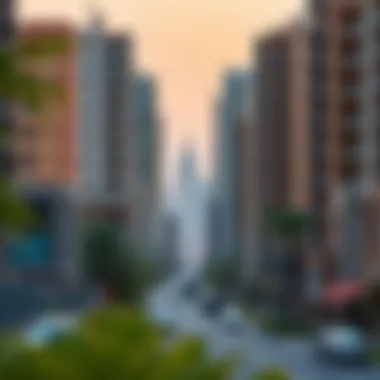

Intro
Dubai's real estate landscape is as vibrant as its skyline. To truly grasp the essence of property investment here, one must first peel back the layers of its neighborhoods. Each area presents a unique tapestry of culture, community, and economic potential. Streets bustling with life, pristine parks, and towering buildings encapsulate the dynamic lifestyle that Dubai offers.
In exploring neighborhood dynamics, we uncover factors such as demographics, lifestyle preferences, and physical amenities that play pivotal roles in shaping property values and investor decisions. Investors and homeowners alike find themselves at a crossroads, where understanding these dynamics not only empowers their choices but also enhances their potential returns. As the city continues to grow and evolve, the significance of local context in real estate cannot be overstated.
Whether you’re a seasoned investor or a curious onlooker, grasping the intricacies of Dubai’s neighboring areas is crucial for navigating this multifaceted urban landscape. Now, let’s take a closer look at some specific aspects influencing the real estate market in Dubai.
Market Trends and Analysis
The real estate market in Dubai is a living organism; it pulses and expands based on various interrelated factors. Understanding the current market conditions, alongside potential growth areas, grants stakeholders a clearer perspective on investment opportunities.
Current Market Conditions
The current market in Dubai reflects a shift towards sustainability and quality of living. Areas like Dubai Marina and Downtown Dubai continue to attract attention due to their unmatched amenities and central locations. Recent statistics indicate that property prices in these regions have stabilized after a period of volatility. The demand for luxury apartments has surged, driven by expatriates and affluent investors who seek a blend of lifestyle and investment return.
Conversely, the suburban areas such as Dubai Investment Park and Mohammed Bin Rashid City have gained traction as affordable alternatives. These neighborhoods offer larger spaces, appealing particularly to families looking for more value in their investments.
Future Predictions and Growth Areas
Looking ahead, attention is shifting towards less established areas with planned developments. Locations such as Dubai South and the upcoming Dubai Creek Harbor are projected to experience significant growth, driven by infrastructure investments and increasing demand for mixed-use developments. Factors such as government initiatives focusing on green spaces and improved transport links could further enhance the appeal of these neighborhoods.
As the city expands, understanding which neighborhoods will bloom may very well determine the future of your investment portfolio.
Property Investment Strategies
Choosing the right property type is just the start; navigating financing options adds another layer to the intricate process of investing in Dubai real estate.
Types of Properties to Consider
In Dubai’s diverse market, understanding which types of properties yield beneficial returns is crucial. Here’s a quick overview of what potential investors should contemplate:
- Luxury Villas: These are for buyers looking to capitalize on high-net-worth clientele.
- Apartments in Prime Areas: Ideal for rental yields, particularly in high-demand neighborhoods.
- Off-Plan Developments: These present opportunities for significant appreciation once completed.
- Commercial Real Estate: As businesses expand, investing in commercial properties can also yield long-term stable income.
Financing Options and Considerations
When it comes to financing your property in Dubai, various routes are available. Here are some avenues to explore:
- Mortgage Loans: Offered by a range of banks, terms can vary widely based on the lender.
- Developer Financing Plans: Many developers offer incentives to buyers, making initial investments easier.
- Cash Purchases: For serious investors, cash transactions can secure better deals and minimize costs associated with financing.
Understanding the nuances of these options can pave the way for smarter investment decisions.
By delving into these layered dynamics, we equip ourselves with the knowledge necessary to excel in Dubai’s ever-changing real estate market. The next sections will further illuminate how lifestyle implications shape buyer decisions and overall property values.
Understanding Neighborhoods in Dubai
Understanding the neighborhoods in Dubai is paramount when exploring the real estate market. Dubai is a sprawling metropolis, characterized by a diverse array of communities, each boasting distinct features and amenities. The level of importance surrounding these neighborhoods cannot be overstated, particularly for potential buyers, investors, and other stakeholders in the property market.
To truly appreciate the essence of real estate in Dubai, one must comprehend how neighborhoods function in unison. Each neighborhood has its own flavor, influenced by its demographics, culture, and urban design. For instance, the bustling streets of Deira are a far cry from the stylish high rises of Dubai Marina. As a potential homeowner or investor, knowing these nuances can mean the difference between making a sound investment or getting lost in the shuffle of this vibrant city.
The Benefits of Understanding Neighborhoods
- Informed Decision Making: Knowing the specifics of a neighborhood helps buyers align their choices with their lifestyle preferences or investment strategies.
- Market Trends Insight: Familiarity with neighborhood characteristics can provide insights into property value trends, helping investors predict future growth or decline.
- Community Engagement: Understanding the dynamics of local communities fosters better social engagement. Buyers and renters can find a sense of belonging more easily.
- Amenities and Services: Different neighborhoods offer unique amenities, such as schools, parks, shopping centers, and healthcare facilities. Knowledge of these elements aids in assessing the practicality of living in those areas.
- Regulatory Considerations: Each neighborhood operates under various zoning laws and regulations. Grasping these details avoids legal pitfalls and aligns investments with local requirements.
In summary, gaining a clear understanding of neighborhoods in Dubai is not just beneficial; it is essential. The intricacies of each area shape the real estate landscape in ways that could spell success or failure for those involved. With this awareness, stakeholders can navigate the vibrant and multilayered urban tapestry of Dubai more effectively.
Defining Neighborhoods
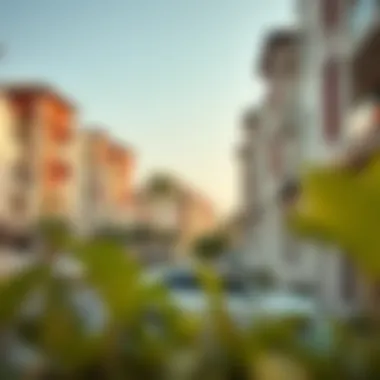
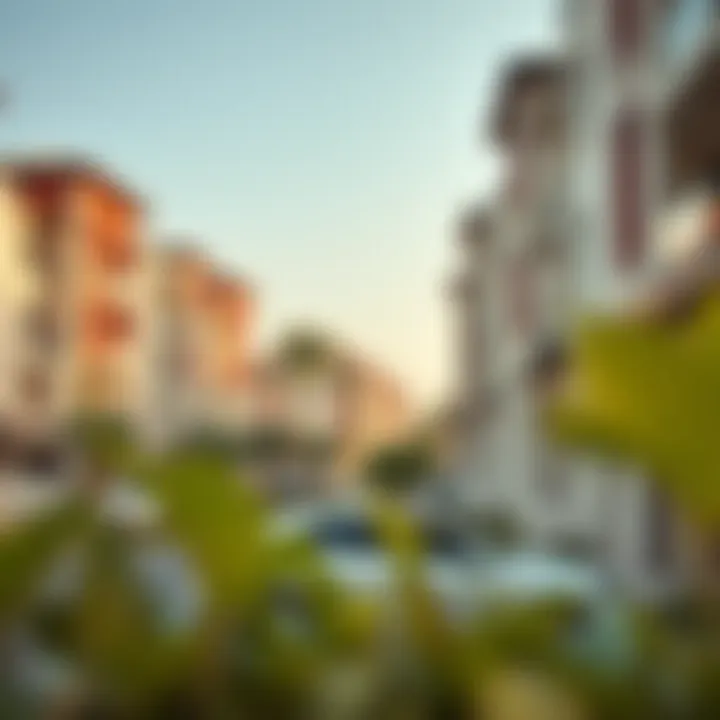
Neighborhoods are not mere geographic delineations; they are communities filled with life, culture, and interaction. In Dubai, the definition of a neighborhood goes beyond its physical boundaries. It encompasses the social and economic characteristics that define the people residing there. A neighborhood in Dubai may consist of high-rise apartments, luxury villas, or even traditional souks, each fostering unique social dynamics.
When defining neighborhoods, one must take into account:
- Cultural Heritage: Some neighborhoods retain traditional Emirati influences, complete with market stalls and cultural festivals, while others are modern enclaves catering to expatriates.
- Residential Composition: Properties vary greatly, from upscale apartments in Downtown Dubai to more budget-friendly options in Al Quoz.
- Access and Connectivity: The availability of transport links and proximity to key areas can have a major impact on how neighborhoods are defined, making places more appealing to residents and investors alike.
With these factors in mind, defining what constitutes a neighborhood in Dubai involves a multifaceted approach, considering both tangible and intangible qualities. Understanding these definitions can help potential residents or investors identify the best fit for their particular needs.
The Role of Neighborhoods in Real Estate
Neighborhoods play a critical role in shaping the real estate market in Dubai. One can think of neighborhoods as the backbone of the real estate economy. Their characteristics directly influence property demand, value appreciation, and even rental yield.
- Investment Potential: A neighborhood's reputation can make or break an investment. Prestigious areas like Palm Jumeirah often see higher demand and property values compared to emerging districts, which might still be gaining traction.
- Buyer Preferences: Many buyers consider factors such as safety, amenities, and community spirit. Neighborhoods that foster active local engagement or provide excellent schooling options often attract families and expatriates looking for long-term commitments.
- Market Stability: Areas that have a good mix of residential, commercial, and recreational spaces tend to be more resilient in economic downturns. Understanding which neighborhoods offer this balance is vital for investors.
"The fabric of Dubai's neighborhoods is woven with the threads of community spirit and economic potential. Understanding this fabric is crucial for anyone looking to make an informed real estate decision."
Key Characteristics of Dubai Neighborhoods
Understanding the key characteristics of neighborhoods in Dubai is essential for anyone looking to navigate its constantly evolving real estate market. Neighborhoods are not merely clusters of buildings; they embody the social fabric and lifestyle choices of their residents. The nuances within these communities can substantially influence property values and investment decisions. By examining core aspects like demographics, cultural influences, and urban design, stakeholders can make more informed decisions that align with their needs and aspirations.
Demographic Trends
Dubai is a melting pot of cultures, and this is reflected in its demographic trends. The city attracts a wide spectrum of residents from all over the world, resulting in a rich tapestry of nationalities and backgrounds. For example, areas like Jumeirah and Downtown Dubai are popular among expatriates due to their vibrant lifestyle offerings and proximity to business hubs.
- Population Diversity: The blend of cultures creates unique neighborhoods, where you can experience different cuisines, languages, and traditions. An increasing number of young professionals are settling in areas like Dubai Marina, which offers a bustling atmosphere with modern amenities.
- Age Distribution: Understanding age demographics can guide potential investors. For instance, neighborhoods primarily inhabited by families may prioritize educational facilities and parks, while areas popular with young professionals might emphasize nightlife and dining options.
Cultural Influences
Cultural influences significantly shape the character of various neighborhoods in Dubai. Each area has its unique identity, often influenced by the predominant cultures of its residents.
- Community Events: Neighborhoods frequently host cultural festivals that celebrate local and international traditions. Such events foster community spirit and make these neighborhoods attractive to prospective buyers or renters.
- Architectural Styles: The designs of buildings often reflect cultural heritage. For instance, the traditional Arabic architecture in Al Fahidi contrasts with the sleek modernity of business districts, highlighting the city’s historical depth.
- Religious Facilities: The presence of mosques, churches, and temples showcases Dubai's commitment to multiculturalism. Communities often gather to participate in religious activities, making these spaces essential to neighborhood dynamics.
Urban Planning and Design
Urban planning in Dubai is a reflection of its ambitious vision for growth and sustainability. The layout of neighborhoods is not just a matter of aesthetics; it's about functionality and livability.
- Mixed-Use Developments: Many neighborhoods feature mixed-use spaces where residential, commercial, and recreational areas coexist. This approach encourages a vibrant community life and reduces reliance on cars, promoting walkability. Dubai's Development Control Regulations ensure that new projects integrate these principles.
- Green Spaces: Parks and public spaces are integral to urban planning. Neighborhoods like Al Barsha and Mirdif are known for their parks, offering residents a retreat from the fast-paced urban life.
- Transportation Linkages: Efficient public transportation links, like the Dubai Metro, greatly influence neighborhood desirability. Areas close to metro stations see a surge in property values, making connectivity a crucial factor for potential investors.
In summary, the key characteristics of Dubai neighborhoods reveal much more than their visual appeal. They illustrate how demographics, cultural nuances, and thoughtful planning contribute to the urban landscape, providing crucial insights into real estate dynamics.
Market Trends in Dubai Neighborhoods
Understanding market trends in Dubai neighborhoods is like reading the pulse of the city's real estate ecosystem. It's vital for real estate agents, investors, expatriates, homeowners, and developers to grasp how these trends shape property values, buyer preferences, and investment opportunities. Keeping tabs on market dynamics ensures that one stays ahead of the game and makes informed decisions, which can have significant financial implications. Here, we will delve into the aspects of property value fluctuations, investment hotspots, and emerging neighborhoods that define the evolving landscape of Dubai's real estate sector.
Property Value Fluctuations
In the rollercoaster ride of Dubai's real estate market, property value fluctuations are almost par for the course. Factors influencing these swings can vary from global economic conditions to local supply and demand dynamics. For instance, during economic downturns, property values might dip as buyer confidence wanes. Conversely, in times of booming economic growth, property prices can skyrocket, leaving potential buyers feeling the pinch.
The smart investors watch for signals that suggest when to buy or sell. Some useful indicators include:
- Market absorption rates: This indicates how quickly properties are being sold in a neighborhood. Higher absorption rates suggest a buzzing market, while lower rates indicate stagnation.
- Rental yields: These can provide insight into how much income a property generates in relation to its value. Generally, a yield above 8% is considered attractive for investors.
- Comparative sales: When prices of similar properties in the area show a consistent upward trend, it often indicates that the neighborhood is gaining popularity, thus signaling potential price increases.
Investment Hotspots
When it comes to investment hotspots in Dubai, there are always areas that stand out like a sore thumb in a crowd. These neighborhoods often offer a combination of attractive prices, strategic location, and a strong amenities base. For instance, areas like Dubai Marina and Downtown Dubai regularly attract significant investor interest. Their combination of luxury lifestyle, high rental returns, and network connectivity makes them prime choices.
However, lesser-known neighborhoods are rising to prominence thanks to improved infrastructure and favorable developers’ projects. These areas can present a golden opportunity for savvy investors looking to get the jump before they become mainstream. Here are a few current hotspots to consider:
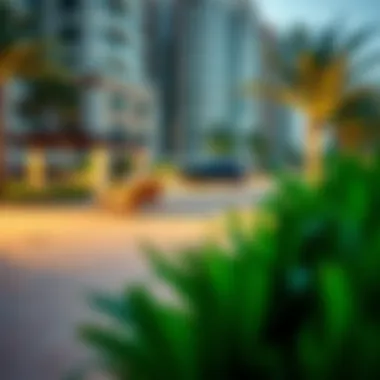
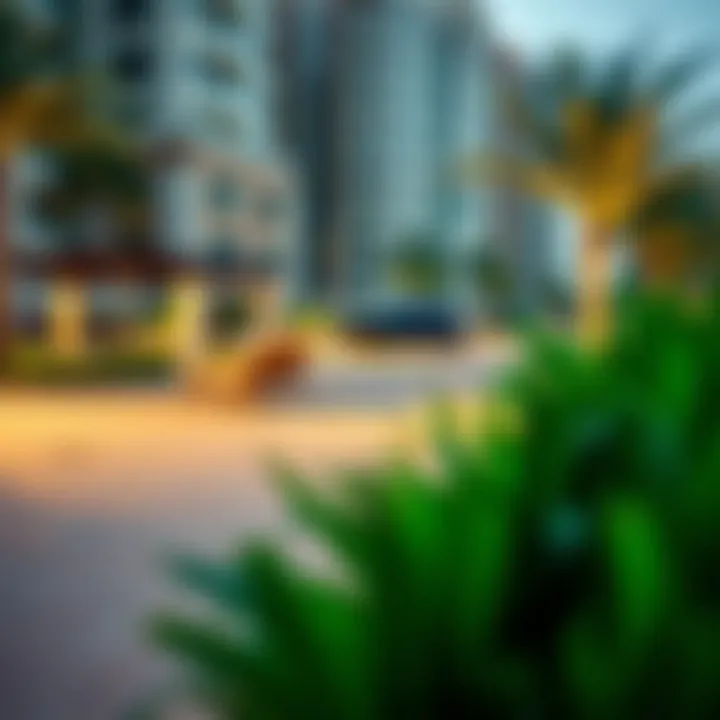
- Dubai South: As the location of the upcoming Expo 2020, this area promises significant long-term value.
- Jumeirah Village Circle (JVC): This community has continued to see a boom thanks to affordable properties attracting young professionals and families alike.
Emerging Neighborhoods
In the fast-paced environment of Dubai’s real estate, spotting emerging neighborhoods is akin to finding the next diamond in the rough. These areas often fly under the radar initially but can eventually blossom into attractive residential and commercial hubs.
For anyone focused on investing, keeping an eye on areas in transition is essential. Places like Al Furjan, which is witnessing rapid development projects, are attracting attention for diverse living options. Similarly, Dubai-Science Park is adding modern residential facilities which are crucial for the growing workforce.
Investors should consider these regions not just for their current appeal, but for their potential:
- Dubai Sports City: Rising sports infrastructure could beckon families and athletes.
- Meydan City: The connections brought about by its high-profile events are fostering growth.
Understanding where these markets are heading can present immense possibilities for future appreciation.
As the city continues to develop and transform, identifying these trends and recognizing potential opportunities becomes fundamental for anyone involved in Dubai's real estate landscape. Keeping abreast of how these trends can affect market positions positions everyone for success in this dynamic environment.
Amenities and Services in Different Neighborhoods
Amenities and services play a crucial role in shaping the livability and attractiveness of neighborhoods in Dubai. They strongly influence both property values and the overall quality of life for residents. As various neighborhoods emerge and thrive, understanding what they offer in terms of education, healthcare, and recreation becomes vital.
Educational Institutions
When it comes to educational institutions, Dubai’s neighborhoods are often evaluated by the quality of schools and colleges available to residents. Education is a top priority for families; therefore, neighborhoods that provide access to high-quality schools tend to attract more buyers, especially expatriates seeking stability for their children. For instance, areas like Jumeirah and Arabian Ranches are known for their prestigious international schools, like Jumeirah English Speaking School and Ranches Primary School. These schools often follow British or American curricula, making them favorable for expatriates.
Additionally, proximity to higher education institutions like the American University in Dubai can be a significant draw for buyers interested in student housing or investment opportunities. Families will evaluate the balance between the number of schools and their reputations when making decisions about purchasing property. Thus, the availability of diverse educational options directly impacts both residential appeal and property values.
Healthcare Facilities
Healthcare is another critical aspect of neighborhood dynamics. The presence of healthcare facilities like hospitals, clinics, and pharmacies is essential. In densely populated areas such as Deira and Bur Dubai, residents are often in close range to prominent hospitals like Rashid Hospital and Dubai Hospital, renowned for their services. This can provide peace of mind for families, knowing that immediate medical care is nearby.
Moreover, the increasing focus on health and wellness has driven neighborhoods to integrate wellness centers and specialized clinics. Areas incorporating community health services, dental clinics, and even alternative medicine providers can stand out in the crowded market. Residents place significant value on health facilities not only for convenience but for the assurance of quality care affecting their lifestyle and investment in their homes.
Recreational Areas
Recreational spaces are the heartbeat of community engagement, providing residents with essential leisure activities and gathering spots. Neighborhoods that boast parks, beaches, and sports facilities tend to cultivate a vibrant social atmosphere. Places like Al Barsha, which features the expansive Al Barsha Park, or Dubai Marina, known for its proximity to JBR Beach, showcase how recreational areas can enhance livability.
These amenities encourage a sense of community, allowing residents to engage in activities, whether it's participating in local sports leagues or enjoying weekend family picnics. Neighborhoods enhancing their recreational offerings also see increased interest from potential residents, affecting real estate demand.
The presence of recreational amenities not only fosters community interaction, but it also often correlates with an increase in property values due to the enhanced lifestyle opportunities they offer.
In summary, the integration of vital amenities and services tailored to educational needs, healthcare requirements, and recreational pursuits greatly shapes the attractiveness of Dubai neighborhoods. Buyers are systematically drawn to areas where they can access these essentials conveniently, resulting in a dynamic interaction between amenities and property desirability.
Community Dynamics and Engagement
In the vibrant tapestry of Dubai's real estate scene, community dynamics and engagement play a pivotal role. Understanding how residents interact with one another and with local governance structures provides critical insights not only for investors but for anyone looking to make Dubai their home. The social fabric of a neighborhood influences property values and buyer interest, making it essential to consider these dynamics when exploring real estate options.
Local Governance
Effective local governance in Dubai neighborhoods is the linchpin of successful community life. Local councils and authorities not only enforce regulations but also cater to the specific needs of residents. For instance, many neighborhoods have their community representatives who bridge the gap between citizens and local government. This relationship aids in addressing issues like waste management, traffic flow, and public safety concerns.
Moreover, local governance shapes the investment landscape. It’s not uncommon for potential buyers to assess how responsive local authorities are before making a purchase. For instance, areas with active engagement from local governance often enjoy better upkeep and enhancements in public amenities. This directly affects the livability and, consequently, the property values within these neighborhoods.
Neighborhood Associations
Neighborhood associations are crucial in fostering community spirit. These groups often act as the voice of the residents, organizing meetings and discussions that tackle neighborhood concerns. They pay attention to detailed community issues such as parking regulations and public events, while also promoting social cohesion through various activities.
In Dubai, each neighborhood may have its associations that cater to the diverse expat population, addressing unique cultural needs and interests. These associations help newcomers feel at home and encourage interactions that might not happen spontaneously in such a bustling city. Buyers frequently look for properties in communities with strong associations, as these serve as a sign of an engaged and active population.


Social Events and Activities
Social engagement is often the heartbeat of any thriving neighborhood. Regular social events and activities contribute to the vibrancy of the community and enhance the sense of belonging. From weekend markets to cultural festivals, these events not only provide entertainment but also foster networking opportunities among residents.
Participating in local events can significantly affect property desirability. Buyers often prioritize communities that facilitate such engagements, as this reflects an active lifestyle and an inviting atmosphere.
Additionally, social events promote local businesses and can improve economic growth within the area. It’s common to see local vendors springing up during community events, offering a taste of the neighborhood’s culture and culinary diversity. When residents come together to celebrate local flavors, arts, and traditions, it not only enriches their lives but also solidifies community ties.
Understanding community dynamics extends beyond mere property transactions; it’s about grasping how people connect, solve issues collectively, and celebrate their differences.
Future Outlook for Dubai Neighborhoods
The future of neighborhoods in Dubai holds a treasure trove of possibilities, significantly impacting the real estate landscape. As one peers into the crystal ball, several key elements become apparent, each playing a crucial role in shaping residential areas. Understanding these dynamics not only enriches the perspective of investors but also aids residents in making informed decisions that align with their long-term aspirations.
Sustainability Initiatives
In the quest for greener urban living, sustainability initiatives are not just a fad but a necessity for future neighborhoods. With the UAE promising ambitious environmental targets, various projects are surfacing that aim to integrate sustainable practices into everyday life. For instance, neighborhoods like Masdar City have become a benchmark for green living, prioritizing energy efficiency and sustainable architecture.
These initiatives provide direct benefits to residents, allowing them to live in environments that foster healthy lifestyles. Some key aspects of sustainability in Dubai neighborhoods include:
- Energy Efficiency: Utilizing renewable energy sources, such as solar power, contributes to a lower carbon footprint.
- Green Spaces: Parks, gardens, and open spaces promote biodiversity and provide leisure areas for families.
- Sustainable Transportation: Integrated public transport systems connect neighborhoods, reducing reliance on cars.
Ultimately, sustainability not only attracts eco-conscious buyers but adds long-term value to properties, making it a focal point in the future of Dubai’s neighborhoods.
Technological Integration
Technology is weaving itself into the very fabric of Dubai neighborhoods, revolutionising not just how people live but also how they interact with their surroundings. This integration manifests in smart homes equipped with IoT devices and cutting-edge infrastructures, like smart waste management systems.
Hold on tight; the implications of technological advancements are vast. Consider the following aspects:
- Smart Home Features: Automation for lighting, security, and temperature control creates a more comfortable living experience.
- Enhanced Connectivity: High-speed internet becomes a staple, facilitating work-from-home options and online learning.
- Traffic Monitoring: Smart traffic lights and real-time updates improve commuter experiences and reduce congestion.
In light of these developments, future neighborhoods will not just be residential zones but technologically advanced ecosystems that enhance daily living.
Vision for Urban Development
Looking ahead, the vision for urban development in Dubai neighborhoods reflects a commitment to innovating while preserving cultural heritage. The strategic urban planning initiatives are designed to support population growth while ensuring that social infrastructure keeps pace.
This vision can be encapsulated in a few guiding principles:
- Mixed-Use Developments: Creating spaces combining residential, commercial, and recreational activities fosters a sense of community.
- Cultural Integration: Incorporating elements from local traditions and heritage into urban design promotes a strong sense of identity.
- Accessible Infrastructure: Well-planned transportation networks ease movement, enhancing connectivity between neighborhoods.
As Dubai continues its journey towards becoming a global hub, these aspects will play essential roles in shaping neighborhoods that are not only livable but also inspire future generations.
The evolution of neighborhood dynamics in Dubai does not merely mirror the architectural marvels of the city; it reflects a holistic approach that intertwines sustainability, technology, and cultural identity.
Finale
In the grand tapestry of Dubai's real estate landscape, the dynamics within neighborhoods stand as fundamental threads. The conclusion of this discussion encapsulates the multifaceted nature of these dynamics and the influence they wield over property investments and resident lifestyles.
Recap of Key Insights
As we've explored, Dubai neighborhoods are not merely geographical entities; they embody vibrant cultures, diverse demographics, and pivotal amenities that shape the day-to-day lives of their residents. Key takeaways include:
- Diverse Demographics: Various communities coexist within the metropolitan area, ranging from expatriates to long-term locals, each contributing to the unique identity of neighborhoods.
- Market Trends: Observations reveal property value fluctuations affected by both local and global market forces. Investors must remain attuned to these trends for informed decision-making.
- Amenities and Engagement: The availability of essential services like schools, healthcare facilities, and recreational spaces significantly enhances the appeal of neighborhoods, steering buyer preferences toward those that offer a comprehensive lifestyle.
"Understanding local dynamics can be the difference between a wise investment and a financial misstep."
These insights underscore the intricate interplay between local influences and investment opportunities, wrapping a detailed picture of why neighborhood characteristics matter.
Implications for Investors and Residents
For investors, a solid grasp of neighborhood dynamics translates to smart investment choices. Properties within burgeoning neighborhoods often present lucrative opportunities, especially those equipped with modern amenities and good infrastructure. On another note, residents benefit from understanding these dynamics as it helps them align their lifestyle priorities with their neighborhood attributes. Choosing the right neighborhood can lead to not just a roof over their head, but more importantly, a thriving community and quality of life.











